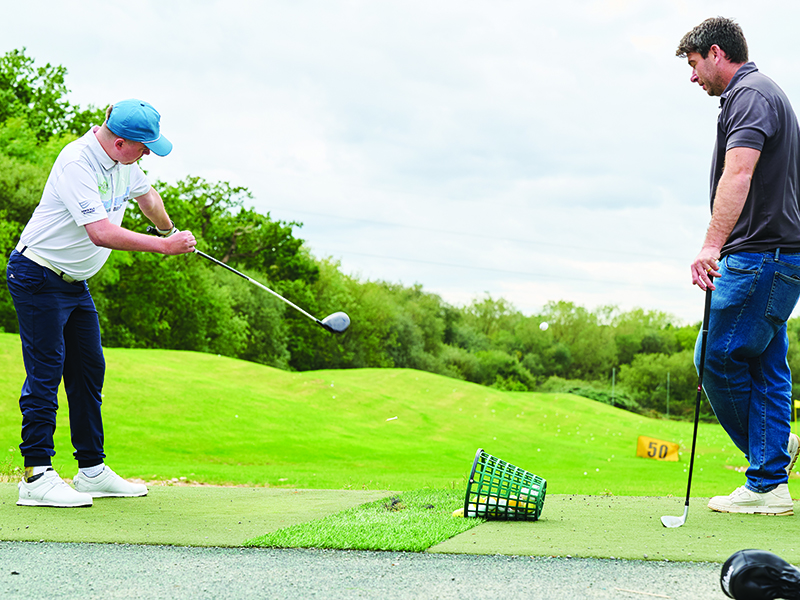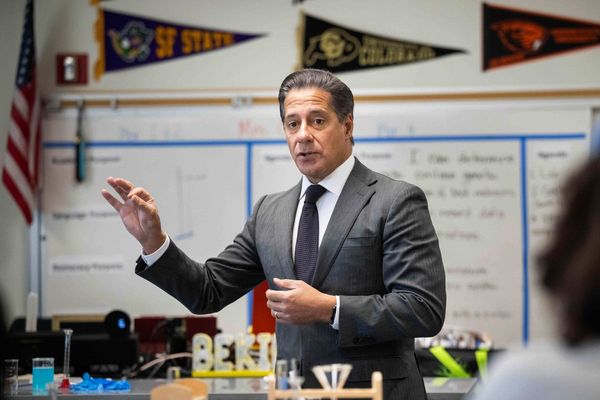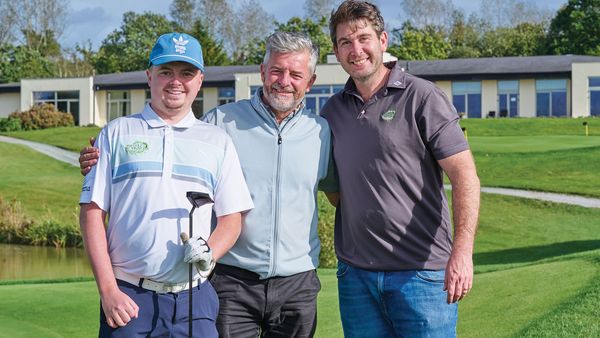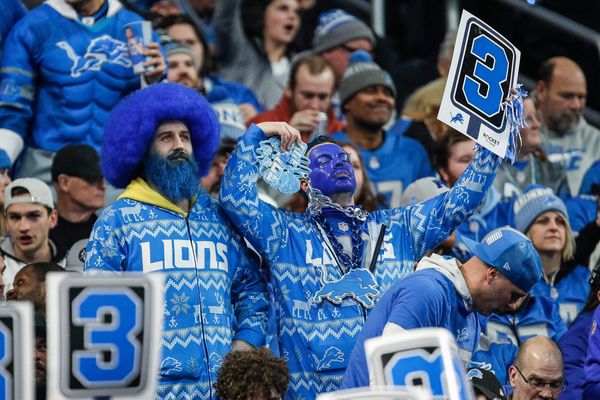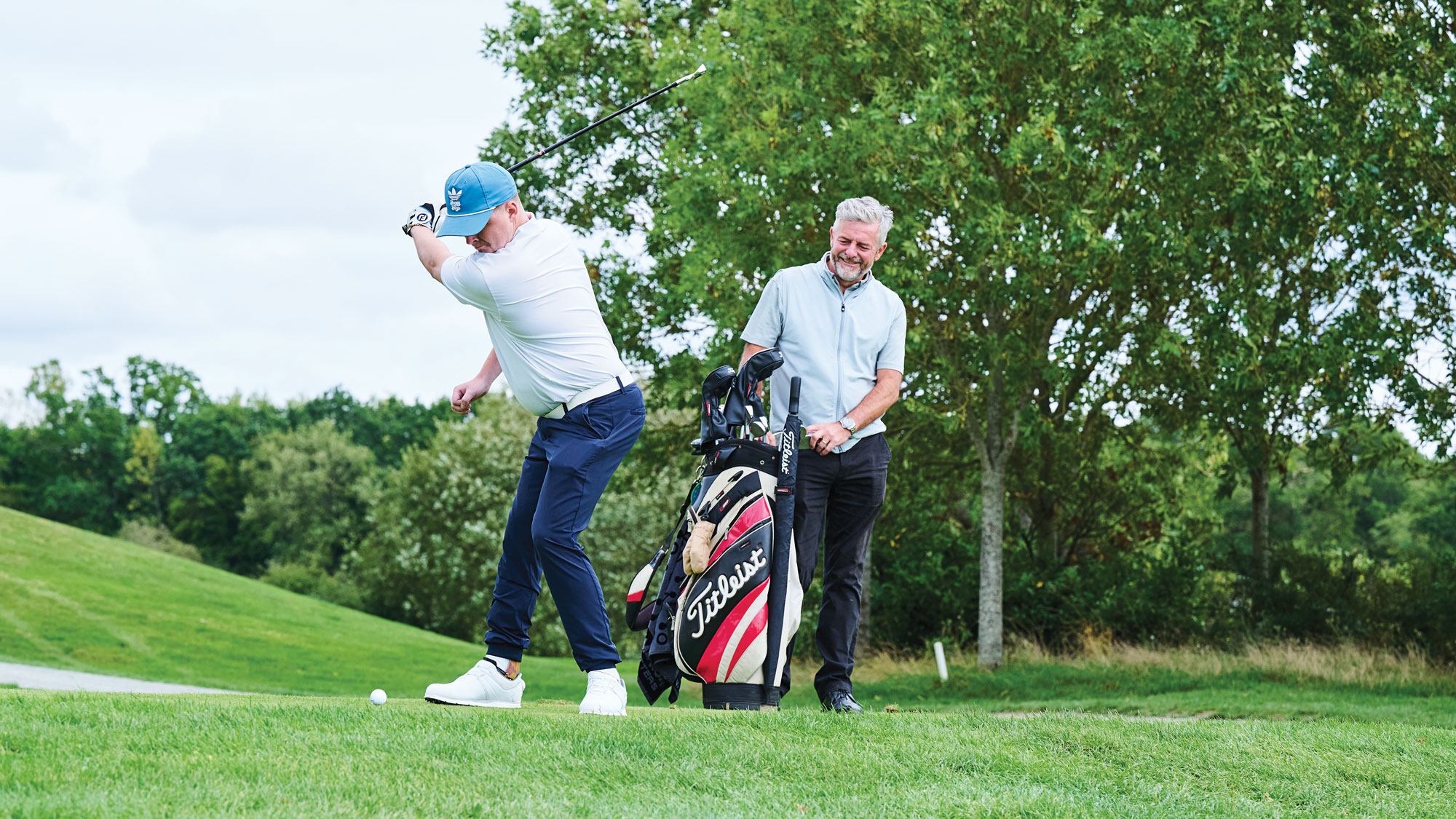
I’ll admit to feeling a little nervous as I sit in a back room at The Shire London with Cae Menai-Davis, whose family run the golf club there. Why? Well, I’m there to chat to Charlie Crosby and his father, Lee, about Charlie’s rehabilitation and return to golf following a major medical episode in 2019 that turned their lives upside down.
I’m nervous that I won’t know quite what to say, but I shouldn’t have worried. A few moments later, there’s a bit of a kerfuffle and much laughter outside before the pair walk in and Charlie greets me with a big, cheeky smile. Yes, walks in – a miracle in itself and something I definitely wasn’t expecting given what I knew of Charlie’s situation.
Laughter remains a common refrain throughout the interview, along with the odd tear from Lee when something I ask triggers a particularly poignant memory. The family has had to travel a long road since that day in June 2019 when Charlie was found unconscious on the floor of his girlfriend’s university flat at 23 years of age.
You may have seen a DP World Tour video from the day Charlie and his family were invited to the BMW PGA Championship in 2021, and they believe certain European Tour pros were instrumental in Charlie coming out of his coma in 2019, more of which in a moment. First, though, how good had Charlie got at golf before his life-changing episode?
“I played as a junior with dad from about five and then didn’t really get serious until I was about ten,” Charlie tells me. I ask when he first beat his dad. “When I was about 13,” he says smiling.
“Yes, he got really good pretty quickly and was captain of the junior team over the road at Old Fold Manor,” dad Lee continues. “He came down rapidly from 16 in the space of about two weeks. The manager kept texting me and saying, ‘It appears Charlie has hit a bit of form,’ because he was playing every day over the summer.”
“I shot one-under in one round,” Charlie interjects.
“Yes, he was off something stupid like 14 and shot one-under gross!” Lee confirms. “It was crazy. I was off about 6 and that’s when he started beating me. He thought he’d become pro, but then realised it wasn’t just chasing the sun around on tour and you actually had to do a bit of work!”
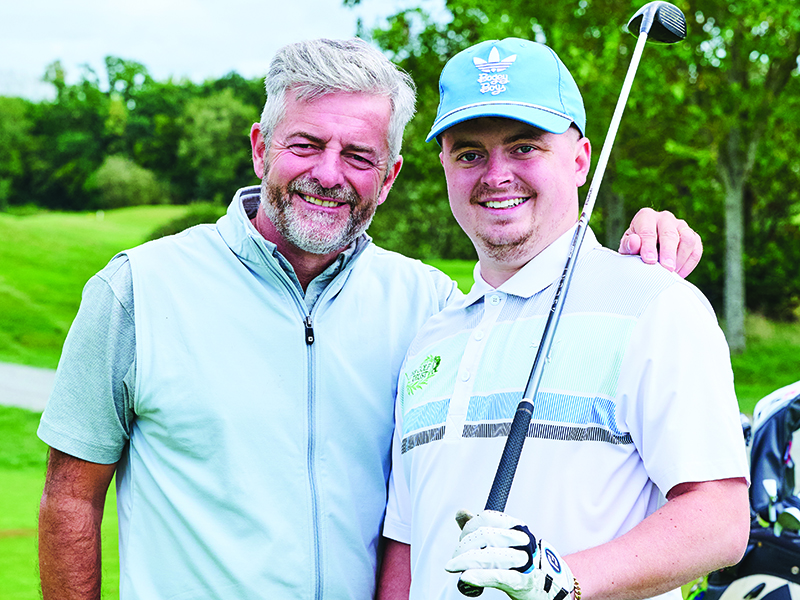
Life-changing Moment
Charlie got down to scratch at one stage and golf was clearly a huge part of life for the Crosbys before the events of June 2019. “Charlie played semi-professional football as well for Cockfosters, but was just getting back into his golf more than football,” Lee tells me. “He had a scratch match at Sandy Lodge and came back and said he was going to get back into it more because he was hitting the ball really well.”
Then everything changed. An AVM – arteriovenous malformation – burst in Charlie’s brain out of the blue. “You’re born with it,” Lee tells me. “They can be anywhere in the body and this happened to be in his brain. It tends to rupture in very fit young men and he was playing semi-professional football and five-a-sides all the time and always in the gym. Once you hit about 30, you’re safe. The surgeon said if he was just a couch potato, it wouldn’t have happened.”
After a delay when medical staff initially thought his unconsciousness was probably drink- or drug-related, a CT scan soon revealed the heartbreaking reality. “They put him into an induced coma on the Thursday,” Lee continues. “On Friday, he had eight hours of surgery. The surgeon came out and said it had been touch and go but he was okay and, me being his dad, the first thing I asked was, ‘Will he ever play golf again?’ because we play in the European Father and Sons together, which is how we’d met professionals such as Richard Mansell and Matt Southgate. He said, ‘No chance.’”
Indeed, Charlie was far from out of the woods, despite the seeming success of that lengthy surgery. On the Saturday, swelling triggered more emergency surgery to which Charlie didn’t react well. “On the Wednesday, they called my wife Carole and me into this room and we knew that was a bad sign,” Lee says. “They said they didn’t think he was going to make it to the weekend so we should start making plans.” Thankfully, Charlie did make it, and from then on kept getting a little stronger. “One morning we woke up and his mum looked at her phone and said, ‘He’s active on WhatsApp!’ It was the most amazing thing. He’d come out of his coma and looked at his phone to see where he was. It was unbelievable.”
Lee and Carole are convinced that a number of DP World Tour pros played a major role here. “Matthew Southgate was sending him messages from different pros saying, ‘Come on Charlie – you’re a fighter. You can do this,’” Lee recalls. “My wife and I were playing these videos to him every day and I’ll swear that was one of the reasons why he came out. We started to see a flickering of the eyes and we’d think, ‘Did we imagine that?’ Then his left hand would start moving. And then, while both Richard and Matt were with him, that’s when he first started to come round.”
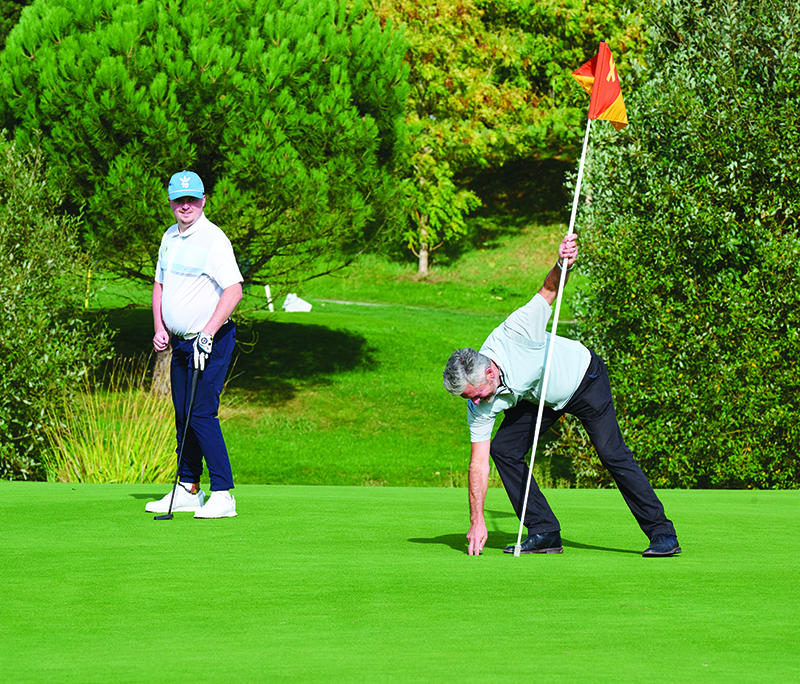
The long road to recovery
Clearly, returning to golf was still a pipe dream at that stage, but despite the surgeon’s initial pessimistic diagnosis, that is exactly what has happened thanks to a huge amount of help from two language therapists, two neuro-physiotherapists, a personal trainer and Menai-Davis. “When we first met, I told Cae what the surgeon had told me,” Lee recounts. “He said, ‘We’ll see about that – we’ll get him playing again.’ Since then, thanks to this man, it’s been unbelievable what’s happened.” This man and a very special machine called the ParaGolfer.
This incredible piece of kit, which I not only get to see, but also end up strapped into, allows disabled people who can’t stand to do just that, thus opening up golf as a possibility once more. Menai-Davis’ charity, The Golf Trust, currently has six around the country used by around 100 people, with plans to acquire more. But they’re not cheap. “Brand new, they’re about £23,000, but we live in the second-hand market,” Menai-Davis tells me. “When you’re in a wheelchair, standing up is so important, not just for sport but for the body.”
To recap, Charlie had right-side paralysis and could barely speak beyond yes and no when he came out of his coma. “Plus the odd swear word,” Lee adds. “The nurses said, ‘The words that come most easily are the swear words, so don’t be offended or surprised – we’re used to that.’ The bleed was on the left side of the brain so it affects the right side of the body. They said straight after the surgery, ‘He will have right-sided paralysis,’ although that’s not permanent. You can train the brain around it and he’s improving with the therapy. But that part of the brain also controls speech and a lot of cognitive things and, again, that’s improved massively.”
Hitting golf balls is now a one-handed experience for Charlie using his ‘good’ left arm. I can tell you from personal experience in the ParaGolfer that left-hand-only golf is so much harder than right-hand only. “That first day was incredible,” Lee reflects, remembering the first time Charlie hit a golf ball again.
“Yes, just seeing you hitting balls together whether it went 5ft, 5 yards or 500 yards – it didn’t matter,” Menai-Davis says. “You were both on the range hitting balls. The goal wasn’t to get him playing The Masters – the goal was to get him playing social golf again.”
I ask Charlie what his first shot back felt like. “Weird – I lost a ball,” he tells me. And how soon before one came out of the middle? “Five minutes,” he smiles.
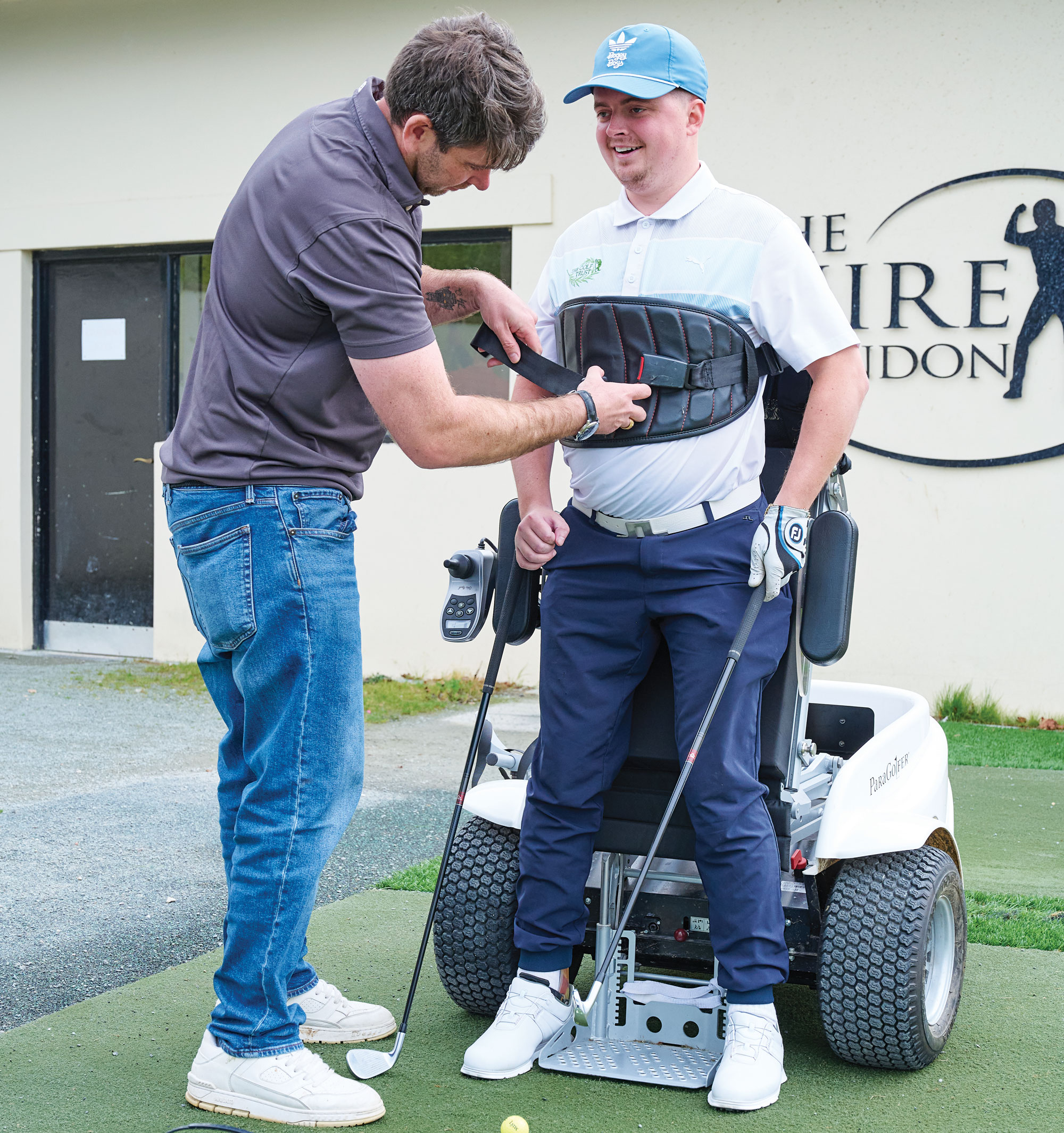
Astonishing progress
“We don’t putt first – we try to make a bigger movement, whereas if you were teaching a junior we would go putt, chip, pitch, full swing,” Menai-Davis explains. “But I was scared of hurting Charlie when he stood. A small movement actually needs bigger muscle groups and we didn’t know where he was at physically. With disability, you’ve got to learn the person, what they can and can’t do, and more importantly, what doesn’t hurt them. The biggest thing is confidence that what you’re telling them isn’t going to hurt them.
“The goal was to get it in the air because we were making contact every time, so we got the smash bag out and just got him hitting it as hard as possible to build that left-side resilience. We did five minutes of that, then hit a chip, five minutes then a chip, and the release pattern was getting there. In the second session, it was like a switch had been flicked and every shot was there – the release was there, the extension.”
Eventually, Charlie was able to stand and swing on his own without the ParaGolfer, and now uses a kind of mobility scooter to get around the course - astonishing progress given the surgeon’s original prognosis. “At one point we were told he would never walk, never be able to speak more than one word, wouldn’t be able to eat or drink, would be fed through a tube, so it’s just amazing,” Lee says. “When he goes back to the hospital, they call him a miracle. They say there is no ceiling – especially speech. The biggest thing for you now is speech, isn’t it?”
“Yes,” Charlie agrees, before finding another unlikely positive from this whole experience. “Four years ago, my putting was horrible – now, with one hand, it’s so much better. Putting is easy,” he says. Sounds like a one-handed putting school could be a business opportunity, I suggest. “Exactly!” he laughs.
As for his speech, it seems something called neuroplasticity may hold the key to training the other side of his brain to handle it more. “How they’ve described it to me is, if you imagine the underground map and you want to get from there to there but one station on the route is shut, you have to find another way round it,” Lee explains. “That’s what his brain is doing – finding new routes to the end goal.”
Just as Charlie can remember the first time he beat his father all those years ago, so too can he remember beating him again for the first time after his AVM. He’s quick to remind his dad of this as we draw to a close. “Yes, you did,” Lee smiles.
“Thank you!” Charlie beams.
“But you don’t like to talk about it, do you?” Lee quips back.
Seeing father and son batting it back and forth, as only true golfing pals can, adds a heartwarming element to the story. We all know what a great sport it is that we play, but to see the multiple positive effects that being able to play golf again has brought to Charlie and his family makes it seem all the greater.
For my parting shot, I ask Charlie just how much being able to hit golf balls again has given him a boost. “Lots. It’s changed my life,” he smiles. Remarkable from a young man who has had his life changed so dramatically.
“Yep, we can see it in you,” says his dad proudly.
